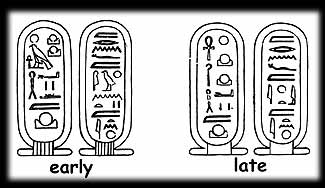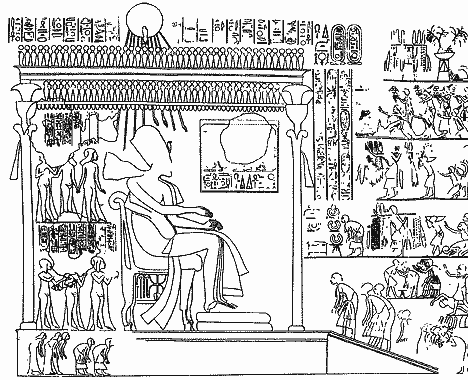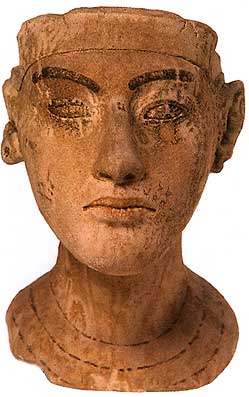|
|
|
 |
|
Year 6 On visiting his city of Akhetaten to view the building operations (still unfinished at that time - it was not until Year 8 that the majority of the buildings were completed), Akhenaten concerned himself mostly with the boundaries of the city and dedicating the entire site to the Aten (he had set up some boundary stelae the previous year - but he returned in Year 6 to finish and also to declare that he would not pass the stelae he had set up (this statement was thought to have meant that Akhenaten would never leave his city, but it is now generally accepted that teh boundary stelae were the obsolute limit for the city of the Akhetaten)). Changes to spelling Gradually between Years 8 and 12 various changes in spelling were enforced -

These changes became more severe as the reign continued enforing the will of the Aten over all other gods. The Durbar of Year 12 The most important event perhaps from Akhenaten's latter years was his Durbar, or jubilee, of Year 12 - it was an occassion for a large gathering of foreign nations (vassal states and the other great powers in Asia) to bring gifts and pay homage to the Egyptian king. One of the questions raised by this durbar is why in Year 12? The traditional time for a king's first Durbar was at the earliest Year 30, - Akhenaten was 18 years too early! C. Aldred has raised the theory that the reason by this premature festival was the final death of Amenhotep III, the end of the co-regency and Akhenaten finally becoming sole king of Egypt.  |
|
|
A Time of sadness The period following the Year 12 Durbar was not a happy time for Akhenaten, indeed the celebration of Year 12 was the final highlight in his reign. Various reports recovered from the Amarna letters show the state of the international affairs, Egypt's vassal states were under increasing pressure from the Mitanni (and other enemies of Egypt) - and so they begged Egypt for help - to no avail, Egypt seemed unwilling to become involved in military action (a far cry for the glory days of Tuthmosis III or Akhenaten's father - Amenhotep III). The deaths of the Royals Scenes from the Royal tomb at Amarna show the death of Meketaten, probably in Year 14, (the 2nd eldest daughter of Akhenaten), along with scenes of mourning from the King and Queen - this relief is the last time Nefertiti is seen in the reign of Akhenaten (although some theories link her with Smenkhkare). It is generally accepted that Queen Tiye (mother of Akhenaten) would have been dead by the time Meketaten was buried as she cannot be recognized among the mourners in the tomb. Following the death of his Chief Queen Nefertiti(again still in Year 14), Akhenaten then married his eldest daughter - Meritaten, and possibly fathered a child by her (Meritaten-ta-sherit). Around the same time also saw the death of the Royal Favourite - Kiya (thought by some to be the mother of Tutankhamun) - the monuments at Amarna / Akhetaten originally built for Kiya were now adapted for Meritaten. Meritaten did not stay the wife of Akhenaten for long - in Year 15 she became queen to Smenkhkare when he was crowned co-regent (Akhenaten took his next eldest daughter, Ankhesenpaaten, as his queen). |
|
Banishing the name of Amun The last two years of his reign were bad times - the deaths of Tiye, Meketaten, Nefertiti, Kiya (probably also - Neferneferure, and other daughters and granddaughters) must have weighed heavily on Akhenaten. Earlier in his reign Akhenaten had identified himself as the son of, and gave complete devotion to the Aten- and in return his god would grant him and his family a long life of happiness and health. It was in such circumstances that the very name of the old god of Egypt, Amun, was to become outlawed : any mention of his name was removed, even from the tips of obelisks, from small scarabs, the name of the Amun element in the name of Amenhotep III - and and every mention of the despised Amun. The news from abroad was desperate too - the Egyptian influence in Syria was almost gone, her position in Central Palestine was also threatened. Akhenaten's Death At somepoint around Year 17 (and in his mid-thirties) Akhenaten died, it is not known in what circumstances. It is presumed that he was buried in his royal tomb at Amarna by his successor Smenkhkare (and Meritaten). Akhenaten's body may have been moved to the Valley of the Kings at a later date (during the reign of Tutankhamun), but it cannot be definitely stated (some view the skeleton found in KV55 as that of Akhenaten, but present evidence shows the skeleton's age to be too young for that of Akhenaten). |

